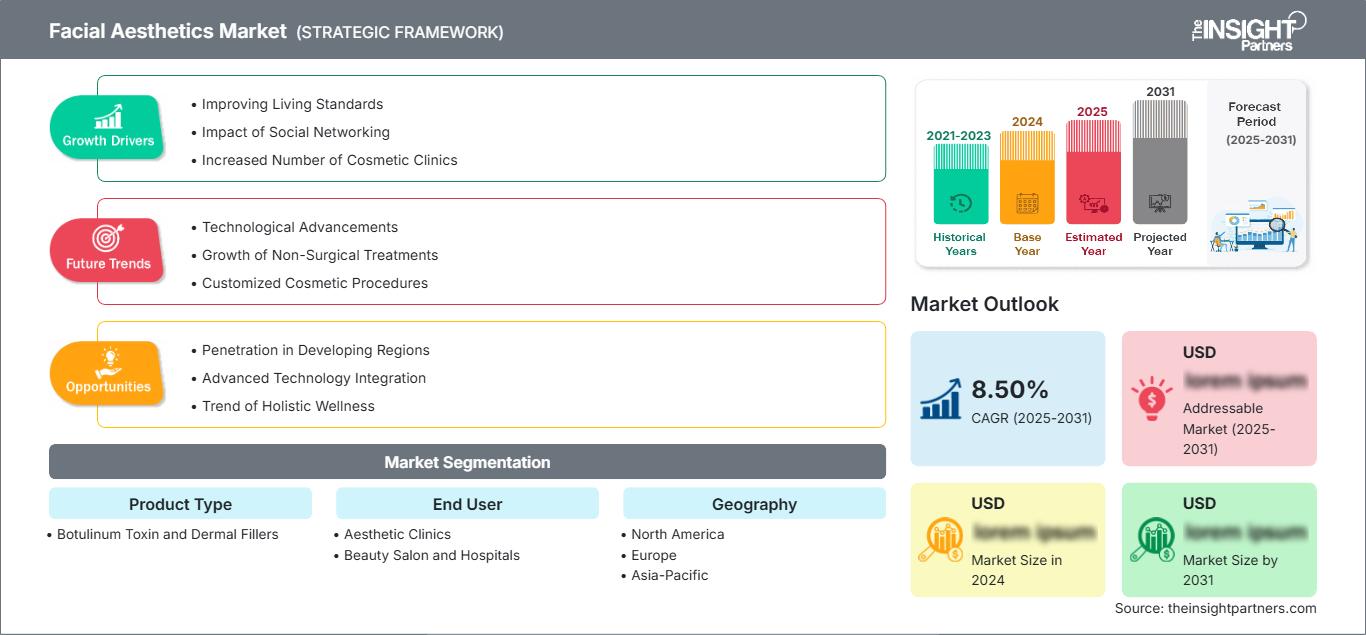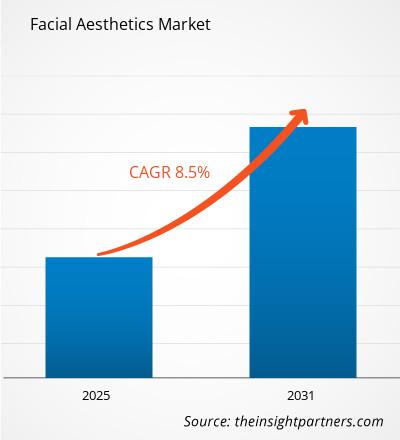Der Markt für ästhetische Gesichtsbehandlungen wird bis 2031 voraussichtlich ein Volumen von 31,8 Milliarden US-Dollar erreichen. Für den Zeitraum 2025–2031 wird ein jährliches Wachstum von 12,4 % erwartet.
Der Bericht analysiert den Markt nach Produkttypen (Botulinumtoxin und Dermalfiller) sowie nach Endnutzern (ästhetische Kliniken, Kosmetikstudios und Krankenhäuser). Die globale Analyse wird weiter auf regionaler Ebene und für wichtige Länder aufgeschlüsselt. Marktgröße und Prognosen für alle wichtigen Marktsegmente auf globaler, regionaler und Länderebene sind enthalten. Die Werte für die Analysen und Segmente werden in US-Dollar angegeben. Der Bericht liefert wichtige Statistiken zum Marktstatus der wichtigsten Marktteilnehmer und zeigt Markttrends und -chancen auf. Ziel des Berichts ist es, die aktuelle Marktlage und das zukünftige Wachstum, die wichtigsten Treiber, Herausforderungen und Chancen zu beschreiben. Dies wird verschiedenen Geschäftspartnern Einblicke bieten, wie zum Beispiel:
- Technologieanbieter/Hersteller: Um die sich entwickelnde Marktdynamik zu verstehen und potenzielle Wachstumschancen zu erkennen, damit sie fundierte strategische Entscheidungen treffen können.
- Investoren: Um eine umfassende Trendanalyse hinsichtlich der Marktwachstumsrate, der Finanzprognosen und der Chancen entlang der Wertschöpfungskette durchzuführen.
- Regulierungsbehörden: Um Richtlinien zu regulieren und Aktivitäten auf dem Markt zu überwachen, mit dem Ziel, Missbrauch zu minimieren, das Vertrauen der Investoren zu wahren und die Integrität und Stabilität des Marktes zu gewährleisten.
Marktsegmentierung für ästhetische Gesichtsbehandlungen: Produkttyp
- Botulinumtoxin und Dermalfiller
Endverbraucher
- Ästhetische Kliniken
- Schönheitssalons und Krankenhäuser
Sie erhalten kostenlos Anpassungen an jedem Bericht, einschließlich Teilen dieses Berichts oder einer Analyse auf Länderebene, eines Excel-Datenpakets sowie tolle Angebote und Rabatte für Start-ups und Universitäten.
Markt für Gesichtsästhetik: Strategische Einblicke

- Holen Sie sich die wichtigsten Markttrends aus diesem Bericht.Dieses KOSTENLOSE Beispiel umfasst Datenanalysen, die von Markttrends bis hin zu Schätzungen und Prognosen reichen.
Wachstumstreiber des Marktes für ästhetische Gesichtsbehandlungen
- Verbesserter Lebensstandard: Das gestiegene verfügbare Einkommen der Verbraucher ermöglicht es ihnen, mehr für persönliche und ästhetische Dienstleistungen auszugeben. Da die Menschen mehr Wert auf Selbstpflege und ihr Aussehen legen, wächst der Markt für ästhetische Gesichtsbehandlungen, da immer mehr Menschen bereit sind, für hochwertige Dienstleistungen zu zahlen, die ihr Aussehen und ihr Selbstwertgefühl verbessern sollen.
- Einfluss sozialer Netzwerke: Das Wachstum sozialer Netzwerke motiviert Menschen dazu, sich ästhetischen Eingriffen zu unterziehen, um ihre Online-Präsenz zu verbessern. Die im Internet propagierten Schönheitsideale und -effekte üben Druck auf die Menschen aus, einem bestimmten Schönheitsideal zu entsprechen, wodurch der Bedarf an ästhetischen Gesichtsbehandlungen steigt, da die Leistung der Einzelnen anhand solcher Online-Bilder verglichen wird.
- Zunehmende Anzahl kosmetischer Kliniken: Die steigende Anzahl von Kliniken für ästhetische Behandlungen, einschließlich medizinischer Spas, hat ästhetische Gesichtsbehandlungen leichter zugänglich gemacht. Der verbesserte Zugang und die einfachere Bereitstellung von Dienstleistungen wecken das Interesse von Verbrauchern, verschiedene Angebote auszuprobieren, was zu einem verstärkten Marktwachstum führt.
Zukunftstrends im Markt für Gesichtsästhetik
- Technologische Fortschritte: Der Markt für Gesichtsästhetik unterliegt einem dynamischen Wandel durch die Einführung von Technologien wie KI-Diagnostik und Bildgebung. Diese ermöglichen eine präzisere Behandlung und bessere Patientenergebnisse, sodass Behandler die Behandlungen effizienter anpassen können.
- Zunahme nicht-chirurgischer Behandlungen: Immer mehr Menschen entscheiden sich für nicht-chirurgische oder scheinbar nicht-chirurgische kosmetische Eingriffe wie Injektionen und Laserbehandlungen. Patienten wünschen sich heute effektive Techniken mit kürzerer Heilungszeit und geringeren Nebenwirkungen. Diese Entwicklung fördert das Marktwachstum, da immer weniger Menschen operative Eingriffe in Betracht ziehen und ästhetische Behandlungen ohne operative Eingriffe immer beliebter werden.
- Individuelle kosmetische Behandlungen: Immer mehr Patienten wünschen sich individuelle Behandlungspläne, da Ärzte vermehrt auf maßgeschneiderte Verfahren setzen. Dies wird durch Fortschritte in der Genetik, der Hautanalyse und anderen Techniken ermöglicht, was zu besseren Ergebnissen und höherer Patientenzufriedenheit und -bindung führt.
Marktchancen für ästhetische Gesichtsbehandlungen
- Erschließung von Wachstumsregionen: Der Markt für ästhetische Gesichtsbehandlungen birgt ein enormes, bisher ungenutztes Potenzial, insbesondere in den wachsenden Märkten Asien-Pazifik und Lateinamerika. Mit steigenden verfügbaren Einkommen und einem wachsenden Bewusstsein für Schönheitsbehandlungen können Unternehmen diese Regionen erschließen, um mehr Kunden zu gewinnen und so ihren Umsatz zu steigern.
- Integration fortschrittlicher Technologien: Die ästhetische Gesichtsbehandlung eignet sich hervorragend für die Integration fortschrittlicher Technologien wie künstlicher Intelligenz (KI) und Augmented Reality. Dies eröffnet zahlreiche neue Möglichkeiten zur Verbesserung des Patientenerlebnisses. Dies wiederum ermöglicht eine optimierte individuelle Behandlungsplanung, verbesserte Behandlungsergebnisse und eine stärkere Einbindung der Patienten. Dadurch können Anbieter technikaffine Kunden gewinnen, die nach innovativen Lösungen suchen.
- Trend zu ganzheitlichem Wohlbefinden: Der zunehmende Trend zu ganzheitlichem Wohlbefinden eröffnet bedeutende Chancen im Markt für ästhetische Gesichtsbehandlungen. Immer mehr Menschen greifen zu Behandlungen, die nicht nur die Schönheit, sondern auch die Gesundheit fördern. Die Integration von Wellness-Praktiken in Ihre ästhetischen Dienstleistungen kann Ihnen eine Vielzahl neuer Kunden bringen und die Kundenbindung in Ihrer Praxis stärken.
Markt für ästhetische Gesichtsbehandlungen
Die regionalen Trends und Einflussfaktoren auf den Markt für Gesichtsästhetik im gesamten Prognosezeitraum wurden von den Analysten von The Insight Partners ausführlich erläutert. Dieser Abschnitt behandelt außerdem die Marktsegmente und die geografische Verteilung des Marktes für das Management von Herzrhythmusstörungen in Nordamerika, Europa, Asien-Pazifik, dem Nahen Osten und Afrika sowie Süd- und Mittelamerika.
Umfang des Marktberichts zur Gesichtsästhetik
| Berichtsattribut | Einzelheiten |
|---|---|
| Marktgröße in 2024 | US$ XX Billion |
| Marktgröße nach 2031 | US$ 31.8 Billion |
| Globale CAGR (2025 - 2031) | 12.4% |
| Historische Daten | 2021-2023 |
| Prognosezeitraum | 2025-2031 |
| Abgedeckte Segmente |
By Produkttyp
|
| Abgedeckte Regionen und Länder | Nordamerika
|
| Marktführer und wichtige Unternehmensprofile |
|
Marktdichte im Bereich der Gesichtsästhetik: Auswirkungen auf die Geschäftsdynamik
Der Markt für ästhetische Gesichtsbehandlungen wächst rasant, angetrieben durch die steigende Nachfrage der Endverbraucher. Gründe hierfür sind unter anderem sich wandelnde Verbraucherpräferenzen, technologische Fortschritte und ein wachsendes Bewusstsein für die Vorteile der Produkte. Mit steigender Nachfrage erweitern Unternehmen ihr Angebot, entwickeln innovative Lösungen, um den Bedürfnissen der Verbraucher gerecht zu werden, und nutzen neue Trends, was das Marktwachstum zusätzlich beflügelt.

- Holen Sie sich die Markt für Gesichtsästhetik Übersicht der wichtigsten Akteure
Wichtigste Verkaufsargumente
- Umfassende Abdeckung: Der Bericht bietet eine umfassende Analyse der Produkte, Dienstleistungen, Arten und Endnutzer des Marktes für Gesichtsästhetik und vermittelt so ein ganzheitliches Bild.
- Expertenanalyse: Der Bericht basiert auf dem fundierten Wissen von Branchenexperten und Analysten.
- Aktuelle Informationen: Der Bericht gewährleistet Geschäftsrelevanz durch die Berücksichtigung aktueller Informationen und Datentrends.
- Anpassungsmöglichkeiten: Dieser Bericht kann an spezifische Kundenanforderungen angepasst werden und sich optimal in die Geschäftsstrategien integrieren.
Der Forschungsbericht zum Markt für Gesichtsästhetik kann somit maßgeblich dazu beitragen, das Branchenszenario und die Wachstumsaussichten zu entschlüsseln und zu verstehen. Auch wenn einige berechtigte Bedenken bestehen, überwiegen die Vorteile dieses Berichts insgesamt die Nachteile.
- Historische Analyse (2 Jahre), Basisjahr, Prognose (7 Jahre) mit CAGR
- PEST- und SWOT-Analyse
- Marktgröße Wert/Volumen – Global, Regional, Land
- Branchen- und Wettbewerbslandschaft
- Excel-Datensatz
Aktuelle Berichte
Verwandte Berichte
Erfahrungsberichte
Grund zum Kauf
- Fundierte Entscheidungsfindung
- Marktdynamik verstehen
- Wettbewerbsanalyse
- Kundeneinblicke
- Marktprognosen
- Risikominimierung
- Strategische Planung
- Investitionsbegründung
- Identifizierung neuer Märkte
- Verbesserung von Marketingstrategien
- Steigerung der Betriebseffizienz
- Anpassung an regulatorische Trends




















 Kostenlose Probe anfordern für - Markt für Gesichtsästhetik
Kostenlose Probe anfordern für - Markt für Gesichtsästhetik